| |

Traditions, folklore, history and more. If it's Irish, it's here. Or will be!
"People will not look forward to posterity who never look backward to their ancestors."
-Edmund Burke




Quotes
Library: Books, Movies, Music
Prints & Photos
Poetry
Jokes


Shops Ireland
Bunús na Gaeilge
(Basic Irish)
Circle of Prayer
Blessings
Did You Know?
Himself/Herself
Write to Us
Readers Write..
Links/Link to Us
Advertise with us
Awards & Testimonials
Submissions Guide

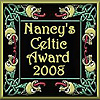
|
|
|
 Creepy Irish Castles and Houses Creepy Irish Castles and Houses
by Bridget Haggerty
Only in Ireland will you hear terrifying tales of shots still being heard in the execution yard of St. John's Castle in Co. Limerick; of a Cistercian monastery and graveyard where a strange ball of fire is sometimes seen; of Cuffesborough House with its phantom horse; of Castleboro House where Lady Carew still tries to rescue her needlepoint from fire; and then, there's Aughanure, where the Hangman Hempenstall still walks, and let's not overlook Mullingar and Lord Belvedere's "jealous wall"....
With a history steeped in violence and bloodshed, it should come as no surprise that Ireland can claim dozens of locations where grisly deeds have given rise to ghastly hauntings. Come with us as we explore a few of the more notorious haunts - places where spine-tingling tales of murder and mayhem will make the blood run cold.
McMahon's Castle in Co. Clare
Here, in the derelict shell, is a sealed room which contains an evil so great that no one has looked upon it and lived to tell the tale. The last time the stones that seal the chamber were opened was in the late 1920s. It's said that an exorcist went into the chamber to deal with whatever dreadful creature was there. He was found the next morning, lying in the remains of the great hall. His death certificate recorded heart failure as cause of death. However, no one who saw the remains is likely to forget the look of pure terror engraved into the features of his face.
Seaforth House in Co. Sligo
Seaforth lies in the shadow of Knocknarea Hill, on the shores of Sligo Bay. It's said that Owen Phibbs, an archaeologist, filled the house with artefacts from the Far East, Syria, and Egypt. Almost as soon as the ancient treasures were installed, unpleasant and malicious activities began to happen. A strange evil figure would be seen on the stairway at night and terrible loud crashes were heard throughout the house. Crockery and ornaments would be found smashed. On one occasion, the whole house shook. Servants would not stay and a gardener was terrified by a tall dark shadowy figure who disappeared into the sea, followed by maniacal laughter. Jesuit priests were unable to rid the place of its ghosts and it was eventually abandoned in the 1940’s. It now stands an empty shell.
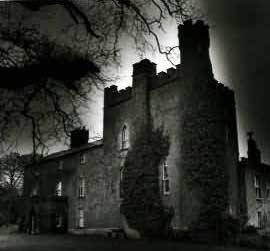 Skyrne Castle, Co. Meath Skyrne Castle, Co. Meath
Nestled between the ancient Hill of Tara where many skeletons have been unearthed and the Gnoc Ghuil, ‘Hill of Weeping,’ lies Skyrne Castle. Built by the Norman knight, Adam de Feipo, in the 12th century, Skyrne is said to be haunted by several spectres that include a nun, and a tall, cloaked figure and his dog. But it is the spirit of a woman in white that gives Skyrne its notoriety. The ghost is believed to be that of Lilith Palmerston who was raped and murdered by Phelim Sellers in the 18th century; it is her ghastly shrieks that many believe can still be heard echoing through the castle in the dead of night.
Friar's Bush, Belfast
Not a house or castle, but worthy of note is a dark underground tunnel connecting the Ashby and David Keir wings of Queen's University. It's located near Friar’s Bush, one of the city's oldest graveyards. It's also close to the site of a former monastic settlement that is believed to date back to the fourth century. Many academics refuse to go down the tunnel on their own, spooked by the intense, unnatural coldness. Three men once ventured down. Unknown to the first man, the other two stopped behind him, refusing to go on. The first man felt someone holding his hand but didn't look behind him until he reached the far end, when he realised he was alone.
Glenarm Castle, Co. Antrim
There was once so much paranormal activity here, that the mistress of the house had every room exorcised except the attic - to which, according to the story, all the ghosts immediately fled. The son of the owner says that there used to be a terrible stamping noise from the attic and that one night, the noise was so loud, he was sent to investigate. He switched on the light at the bottom of the stairs and went up. Suddenly, the light turned itself off and he realised that whatever was making the noise had gotten behind him. Somehow, he managed to get back down the stairs and never went up again. The noises continued for years afterwards, and after a skeleton was found on the grounds, the theory is that the house is haunted by someone who was murdered there.
Loftus Hall, Co. Wexford
The structure was built by the 4th Marquis of Ely in 1870-1871 on the ruins of Redmond Hall, which had existed since 1350. Redmond Hall became the property of the Loftus family in 1666, and afterwards the old mansion became known as Loftus Hall. It was here that the famous "ghost" story originated in the middle of the 18th century.
Charles Tottenham came to live there for a time, and on a stormy winter's night, as the family relaxed before a roaring log fire, a stranger arrived on horseback; he was invited to stay the night. After the refreshments, the stranger participated in a game of cards. During the game, a card fell upon the floor. A lady who bent down to retrieve the fallen card was shocked to discover that the stranger had a cloven foot! Immediately she screamed in terror. The "stranger" vanished through the ceiling in a puff of smoke. This was just one of many terrifying experiences associated with Loftus Hall. Fr. Thomas Broaders was called upon to exorcise the disturbing evil spirit, and apparently, his powers worked. He died in January, 1773, and on his tomb in Horetown Cemetery is the following epitaph:
"Here lies the body of Thomas Broaders,
Who did good and prayed for all.
And banished the Devil from Loftus Hall."
Clonony Castle, Co. Offaly
This great square ruin of a tower in the middle of Offaly certainly looks creepy enough. It dates back to the 16th century, and has a connection with Anne Boleyn - two of her cousins are buried in a cave beneath the castle. The ghost that people see is that of a man standing on top of the tower in old-fashioned dress. His identity remains a mystery, but he is still regularly seen by passing motorists at night, who have described a tall, thin, almost skeletal figure, surrounded by a hazy, luminous light.
Killua Castle Co. Westmeath
The family seat of the great T.E. Lawrence (Lawrence of Arabia), it is said to be haunted, by the land steward (Jacky Dalton) of Sir Benjamin Chapman. No one knows why, but his eccentric spirit has terrified several nocturnal visitors to the castle. The house was long ago abandoned after too many complaints about things that went bump in the night. To this day, a white phantom is said to encircle the ruins, and a hideous, evil-eyed figure has often been seen within the walls.
Athcarne Castle, Co. Meath
This sombre 16th-century ruin lies only 6 miles from the site of the Battle of the Boyne. People have told of hearing the cries of dying soldiers, the manifestations of a soldier hanged from a great oak tree in the grounds have been seen, and the spectre and demented face of a young girl, whose hands are dripping with blood, was witnessed by a labourer a few years ago.
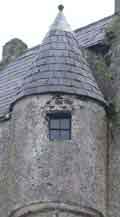 Ballygally Castle Hotel, Co. Antrim Ballygally Castle Hotel, Co. Antrim
Not all hauntings are malevolent or sorrowful; Ballygally is reputed to be haunted by the ghost of a Madame Nixon who lived there in the 18th century. After she died, it was said that she wandered the passages at night and amused herself by knocking on the doors of different rooms.
Her fleeting appearances have recently been confined to a room in a corner turret. Another story is fascinatingly eerie. Two elderly guests booked in for several days over the Christmas season. On arrival they were intrigued to discover the staff were preparing for a fancy dress ball. That night there was a knock at the bedroom door and there stood one of the waiters clad in medieval costume. He had arrived to invite them to the ball. They went and enjoyed a lovely evening surrounded by staff and other guests all bedecked in wonderful attire. The next morning at breakfast they enthused to their hostess about what a wonderful evening it had been. This came as a bit of a shock, for the ball had not taken place yet and was not due to take place for another two days. The elderly guests hurriedly checked out.
Dower House, Killackee, Co. Dublin
Ghostly apparitions and a large phantom black cat have all seen on the premises of this house. The owner, Mrs Margaret O’Brien, was sceptical until she saw the cat squatting in her hallway. She said all doors of the house were locked and it couldn’t have entered by any normal means. On another occasion, Tom McAssey, a workman at the house, felt a room go icy cold and saw a locked door open. He called for who ever it was to come in, only to be greeted by a deep growling noise. He slammed the door, but it sprang open again, and this time there was a large cat with red and orange eyes sitting there. A shadowy figure growled "You cannot see me. You don’t even know who I am". Mrs O’Brien had an exorcism performed which apparently got rid of the fearsome feline.
Springhill, Co. Derry
Springhill is a 17th-century house which was once the home of ten generations of a single family from Ayrshire. In the late 19th-century, a certain Miss Wilson was residing at Springhill and saw a tall female apparition standing at the top of the moonlit stairs. The ghost approached a door to a room and mysteriously threw its hands up in the air in a grief-stricken manner before vanishing. The same room was occupied in later years by another guest, Miss Hamilton, who reported having witnessed excited servants pouring into the room before the door to the room opened, a light shone in, and the activity ceased. Miss Hamilton was dumbfounded to hear that the owner of the house had papered over that particular door. A governess reported having heard two children in the next room to hers holding a casual conversation about a ghostly woman standing by the fireplace. Teddy Butler, an administrator of the property for a number of years, saw a woman in black at the foot of the stairs, heard the sounds of marching and heavy footsteps on the stairs and landing, and even collided with a woman going through the back door in the middle of the afternoon. This woman is said to have been the wife of Colonel Conyngham who served in the Crimea. Her portrait disappeared from Springhill a few years ago, mysteriously re-appeared wrapped in brown paper, and vanished again. It hasn't been seen since.
Wilton Castle, Co. Wexford
Looming above the landscape of South-eastern Ireland, only the fire scarred-walls remain of once stately Wilton Castle. Until it was ravaged by flames in the early 1920's, this rambling structure was home to generations of the Alcock family, prominent in the region since the early 17th century. If the local legends are to be believed, a fair number of ghosts are now harboured within the castle walls. One story recounts strange lights that are sometimes seen in the ruins of a castle tower where an old woman who was once an actress, died in a fire. Another tale has it that every year on the anniversary of his death, the shadow of Harry Alcock, who died in 1840, is seen driving slowly away from the castle in a ghostly carriage. Crowds once gathered in anticipation of the event, and a local shoemaker claimed to have spoken with the phantom. The strangest tale, however, is that of neighbour Archibald Jacob, who served as a magistrate and captained the local militia company at the time of the rebellion against Britain in 1798. Jacob flogged and tortured many people in the parish. While returning home from a ball at at the castle, he was killed by a fall from his horse. For years afterward, his ghost was said to haunt both the scene of his death and the castle. On one occasion, a Catholic priest was summoned to the castle to conduct an exorcism. When he made the sign of the cross, the ghost of Archibald Jacob allegedly appeared in the fireplace, then disappeared in a cloud of smoke.
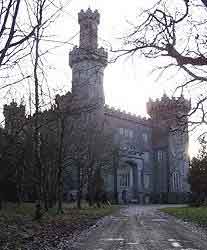 Charleville Castle, Co. Offaly Charleville Castle, Co. Offaly
A clock chimes where there is no clock; chairs rock with no occupants; a child cries and there is no child; glowing fogs float by; bodiless voices and footsteps are heard in the night... As the story goes, the castle was built in the 1700s on top of an ancient druid burial ground where people were once buried alive. It's said that the the man who built it had practiced devil worship; other tales talk of men going mad and locking children in the basement. As recently as the turn of the 20th century, a young girl fell to her death from a staircase banister and it's said her spirit still haunts the stairwell.
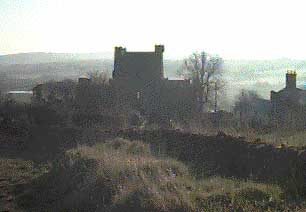 Leap Castle, Co. Offaly Leap Castle, Co. Offaly
While there are literally dozens of haunted houses and castles in Ireland, we've saved the best for last - Leap Castle, once owned by the O'Carrolls.
According to the stories, it was built on a Druidic site. When the O'Carrolls came here they had a nasty habit of murdering people and dropping the mortal remains down a hole in the wall - an oubliette - where they promptly forgot about them. One O'Carroll chieftain murdered his own brother, a priest, for starting Mass too promptly. Hence, the top floor of the castle is called the Bloody Chapel. It was, however, lower down in the castle that "It" was seen - an elemental force of evil with the head of a sheep and the stench of death.
Herewith, a first person account of a visit to Leap:
"Burnt out during the 1920s, Leap's looks lived up to its reputation. Narrow Gothic windows, ivy covered towers, bats and a barn owl, it was like a set from a Vincent Price movie. We crept in through the gaping doorway. Our flashlights revealed a huge hole in the stone floored front hall and we gingerly made our way around the edge, heading for the spiral staircase. No ghost would make us nervous - we were the Dublin Ghost Busters! Despite our confidence, we found ourselves talking in whispers. A slight sound behind me and I spun like a ballerina to see the cause. But as I spun around. I slipped and then dropped through the hole in the floor. The flashlight hit a rock and went out. Just above me, just out of reach, I could see the jagged outline of the floor. I could hear friends coming to help me. And then, in the darkness, I could hear a sniffling snorkly sort of noise. There was a smell, too. A horrid, rotten smell. I am not athletic, but that night, terror put rockets into my heels. I shot upwards. Scrabbling madly I made the doorway and did not stop running till I was safely in the car. That was nearly twenty years ago. Since then various psychics have attempted to purge the place. Priests have said masses there, a medium has planted a special tree there. The last time that I visited it, the castle was being restored and much of the evil atmosphere had gone. Only that small, windowless room underneath the castle still had that sinister feel."
That small, windowless room was the final resting place for scores of victims who were intially locked in a hidden dungeon off the Bloody Chapel. This room had a drop floor and prisoners were pushed into the room where they fell to their deaths - either impaled on a spike below, or if they were unfortunate enough to miss the spike and die a quick death, , they slowly starved in the midst of rotting, putrid corpses.
Around c.1900, workmen who were hired to clean out the windowless room discovered hundreds of human skeletons piled on top of each other. It took three full cart loads to remove all of the bones and one theory is that some of the remains were those of Scots mercenaries hired by O'Carroll who had them murdered when it came time for payment. Mysteriously, among the bones, workmen also found a pocket watch made in the 1840's. Could the dungeon still have been in use back then? No-one will ever know.
Shortly after the gruesome discovery in the dungeon, playful dabbling in the occult may have caused the re-emergence of the evil spirits. In 1659, ownership of Leap Castle passed in marriage from the O'Carroll family to an English family, the Darbys. The Darby family turned Leap into their family home, with improvements and additions and landscaped gardens. In the late 19th century, descendants Jonathan and Mildred Darby, were looking forward to raising their family here. The occult was the fashion of the day, and Mildred Darby did some innocent dabbling, despite the castle's history and reputation for being haunted.
In 1909, she wrote an article for the Journal Occult Review, describing her terrifying ordeal. "I was standing in the Gallery looking down at the main floor, when I felt somebody put a hand on my shoulder. The thing was about the size of a sheep. Thin, gaunt, shadowy..., it's face was human, to be more accurate... inhuman. It's lust in its eyes, which seemed half decomposed in black cavities, stared into mine. The horrible smell one hundred times intensified came up into my face, giving me a deadly nausea. It was the smell of a decomposing corpse."
The spirit is thought to be a primitive ghost that attaches itself to a particular place. It is often malevolent, terrifying and unpredictable. The Darbys remained at Leap until 1922. Being the home of an English family, it became the target of the Irish struggle for independence. Destroyed by bombs and completely looted, nothing but a burned out shell remained. The Darby's were driven out.
Totally gutted, Leap Castle was boarded up and its gates were pad locked for over 70 years. Locals have described seeing the windows at the top of the castle "light up for a few seconds as if many candles were brought into the room" late at night.
The castle lay in ruin for decades. But then, in the 1970's, it was purchased by an Australian, who had a white witch brought in from Mexico to exorcise the castle. She spent many hours in the Bloody Chapel and when she emerged, she explained that the spirits at Leap Castle were no longer malevolent, but they wished to remain.
In the 1990's, the castle was sold to the current owners. They are aware of the castle's troubled history. Shortly after moving in, they began restoration of the castle. However, a "freak accident" left the owner with a broken kneecap which delayed restoration work on the castle for nearly a year. One year after his "accident", the owner was back at work when the ladder he was standing on suddenly tilted backwards away from the wall causing him to jump to the ground. The result was a broken ankle and more delays with the restoration. The owners say they would be happy to share the castle with the spirits as long as there are no more "occurrences".
Recently, the christening of the owner's baby daughter took place in the Bloody Chapel. For the first time in centuries, the castle was filled with music, dancing, laughter, and most of all love. To quote those in attendance, it was a "happy, pleasant, wonderful day".
Have the troubled spirits of Leap Castle finally found peace? Assuming they haven't left, one can only hope they have.
For more creepy Irish locations we received a link to a "most haunted" map. To have a good look please click Most Haunted. With thanks from Teresa Devaney marketing manager of the Ocean Sands Hotel.
Further reading or viewing
Castle Ghosts of Ireland - video
This fascinating program explores the eerie halls of Leap Castle, Castle Leslie and Castle Matrix, where a history of the supernatural and an aura of mysticism abound.
The Twilight Hour - Celtic Visions from the Past
by Simon Marsden.
Read our Review The Twilight Hour.
Resources
Content:
Loftus Hall
Images:
Most of the images are from the The Twilight Hour by Simon Marsden
See our other articles on Samhain and Halloween below:
An Irish Hallowe'en - Part 1
An Irish Hallowe'en - Part 2
How the Irish Invented Halloween
A Triple Treat For Hallowe'en
The Churchyard Bride
Creepy Irish Castles and Houses
Creepy Irish Creatures
Irish Ghosts
Something Wicked this way comes - Irish Ghosts by Region
Protect your property and yourself - Make a Parshell Cross for Hallowe'en
The Dullahan
Samhain - The Irish New Year
The Day after Samhain - All Souls Day
|
|
Fri, Sep 27, 2024
 The Galway Hooker The Galway Hooker
This unique vessel, with its distinctive curved lines and bright red sails, originated in the village of Claddagh. During the 19th century, hookers supported a significant fishing industry and also carried goods, livestock and fuel. Seán Rainey is remembered for building the last of the original boats, the Truelight, for Martin Oliver who was to become the last king of the Claddagh; as king, he was entitled to white sails on his boat. Since the mid seventies, many of the old sailing craft which were on the verge of extinction have been lovingly restored and new ones have been built. During the summer months they can be seen at festivals such a Cruinniú na mBád - the Gathering of the Boats - in Kinvara.
Click for More Culture Corner.
One of our favorite resources. A must-have if you want to learn the basics about Irish culture.
Click here for Things Irish.
|
|
|
|
|




 The Galway Hooker
The Galway Hooker